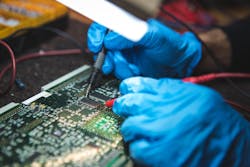Marvell Partners With Facebook to Build Open 5G Base Stations
Marvell said that it has partnered with Facebook to build 5G base stations based on a standard for open radio access networks that allows telecom companies to scale 5G networks faster and more cheaply.
The Santa Clara, California-based company said it would join Facebook's Evenstar project to create a blueprint for a distributed unit (DU) based on its Octeon Fusion baseband procesosrs and Arm-based Octeon data processing units (DPUs). Facebook Connectivity said it would work with Marvell to roll out a software stack for the 4G and 5G reference design, which will be openly shared with telecom firms.
A base station is a setup of boxes used to connect smartphones and other devices to wireless networks. Currently, these boxes are sold by telecom equipment giants such as Nokia, Ericsson, Samsung, Huawei Technologies and other vendors as "all-in-one" systems. These legacy systems tend to be proprietary with custom-designed chips at the heart of the hardware, all coordinated with in-house firmware and software.
To speed up the rollout of 5G networks, telecom firms are trying to disaggregate base station - the radio access network (RAN) - into more compact building blocks, offloading functions to different parts of the network. These include the radio unit (RU) that runs radio frequency functions, the distributed unit (DU) used to carry out baseband processing, and the central unit (CU) that runs software to coordinate it all.
Telecom equipment giants Nokia and Samsung and technology titans like Facebook are investing in the new O-RAN standard to give companies the freedom to mix and match different parts of the network.
Marvell is supplying its 5G chips to leading telecom gear manufacturers including Nokia and Samsung. It is competing against Intel, Broadcom, Xilinx and other rivals to secure slots in 5G networks. The Silicon Valley company said its baseband modems and other networking chips are positioned to replace Intel and Xilinx FPGAs, which are highly programmable but have trade-offs in terms of power consumption and costs.
Decoupling the RU hardware, DU hardware and CU software — which are traditionally sold as a package — would allow telecom companies to choose best-of-breed 5G components. Open RAN uses open software interfaces to reconnect the building blocks of 5G networks, giving telecom companies the flexibility and freedom to roll out 5G features by deploying solutions from an increasing number of technology vendors.
The open RAN standard could also slash costs by replacing the closed, proprietary packages of software and hardware sold by Nokia, Ericcson, Huawei or others that clash with components designed by rivals.
Facebook is also one of the industry leaders behind the Open Compute Project, a separate effort pushing for the use of so-called "white box" networking gear in data centers. As part of the effort, the company openly shares its custom-designed servers and other hardware so that technology vendors can build more scalable and software-defined networking gear in the data center, replacing proprietary designs.
The Silicon Valley titan is trying to bring the same sort of open networking hardware to 5G. It is focused on developing software for Open RAN networks and partnering with other firms to roll out the hardware. Marvell said it would develop a DU reference board featuring its Octeon Fusion-O baseband processors to support 4G and 5G PHY layer processing and its Octeon DPUs to offload and run software functions.
Facebook Connectivity said it would work with Marvell to persude other companies to port protocol stack software to the distribution hardware, which supports up to 16 PHY layers at 100 MHz per channel with 10 Gbps downloads and 5 Gbps uploads. By packaging all the hardware and software together in the same system, the blueprint lowers the bar for telecom companies to build out 5G networks based on O-RAN.
Marvell said Evenstar hopes to have the DU ready to roll out to telecom gear manufacturers by 2022. Other chip vendors that have joined the project include Xilinx and Analog Devices.
About the Author
James Morra
Senior Editor
James Morra is the senior editor for Electronic Design, covering the semiconductor industry and new technology trends, with a focus on power electronics and power management. He also reports on the business behind electrical engineering, including the electronics supply chain. He joined Electronic Design in 2015 and is based in Chicago, Illinois.

